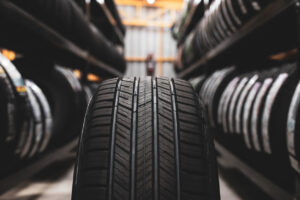Tires are not cheap – especially big rig tires. Over time, tires wear out and need to be replaced. However, some of your driving habits can increase the wear and tear on your tires and reduce their lifespan. So how do your driving habits affect tire wear and tear? There are several reasons behind this. Learn more below about good driving practices and how to avoid added wear and tear due to your driving habits.

Bad Driving Habits
Driving Speeds
When you drive at high speeds while getting to your destination faster, you are also wearing down your tires faster. High speeds make extra friction on the road and cause high heat. Extended exposure to heat softens the rubber and weakens the tire. Within time, this will put your tire at higher risk of blowouts that can cause an increase in a serious injury. If you look at your tires, there is a speed rating on the sidewall. It is advised not to exceed this speed or drive near this limit for long periods.
Extra Heavy Loads
Your tires also have a maximum weight rating located on the sidewall. At the same time, your tires may not explode if you go over this weight limit. Instead, they can become weak and add extra wear and tear. Driving with extra heavy loads puts pressure on your tires in two ways –
- Increasing the temperature that your tire is exposed and;
- Increases the pressure inside the tires
If you need extra heavy loads, look into buying premium tires that can handle the extra weight.
Driving Over Road Debris
We all wish for smooth and debris-free roads, but that is not the case. We often run into situations where there are obstacles on the road, such as steel plates, potholes, branches, uneven seams, gravel, roadkill, glass, and more. So while this debris may not puncture your tire, it can cause your tires to wear down unevenly. If you see debris in the road, try to avoid these if you can. However, if you have to drive over it, do so slowly.
Tire failure is not just from a blowout or flat. Instead, your tires wearing down or the seams bulging can cause a rumbling, vibration, or your truck pulling to one side or the other. When your tire treads wear down, you may also notice you do not have as much traction when driving in wet conditions. Following good driving habits is not only for your safety and others but also for your tires. When you are out on the road, slow down, take turns carefully, and give yourself plenty of time and space to break.
How to Know Your Tires are Worn
Are you wondering if it is time to replace your tires? Many individuals are guilty of driving on worn-down tires and doing things that cause our tires to wear down more quickly. Knowing when to replace your tires is important because healthy tires help with performance, gas efficiency, and safety.
If your tires are worn down, you may need to replace them before losing traction during wet road conditions such as rain or snow. Driving on worn-down tires can also cause other parts of your vehicle. In some states having insufficient thread is illegal. But how do you know when it is time to replace your tires?
One way to tell that your tires need to be replaced is to find a penny. Insert the penny between the grooves of your tire tread. Make sure President Lincoln’s head is facing down. If the tire tread hides any part of his head, your tires are fine. However, if you can see parts of his head, you may need to consider replacing your tires.
So, this method is not always foolproof. Some situations require more tread depth because of the road conditions. Lincoln’s head is about 2/32”, which typically gives you enough traction on dry roads but may not be enough on wet roads.
When water collects on the road, you run into different variables such as water depth, vehicle speed, and weight, along with the tread design and depth. Altogether these variables help determine if your truck will hydroplane and how quickly you can stop.
2/32” is typically a good guide to follow. Still, you should be aware that your tire may not have worn down evenly throughout the entire tire. So, to be safe, you should replace tires at a maximum of 4/32” for stopping. This will give you enough tread when the rain collects on the roadways. However, if snow is a concern, it is recommended to replace your tires at 5/32”.

